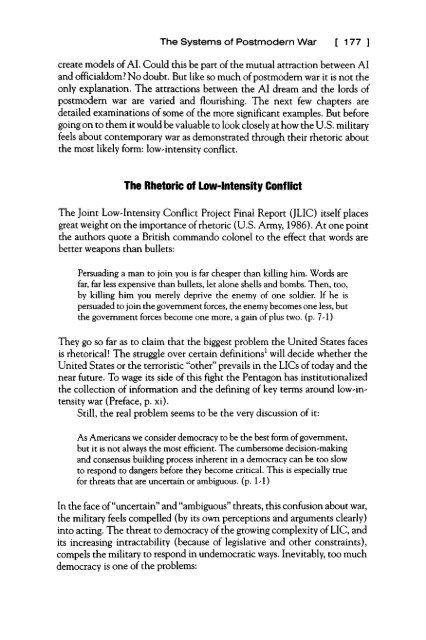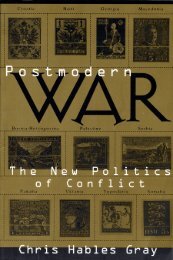9. The Systems of Postmodern War - Chris Hables Gray
9. The Systems of Postmodern War - Chris Hables Gray
9. The Systems of Postmodern War - Chris Hables Gray
Create successful ePaper yourself
Turn your PDF publications into a flip-book with our unique Google optimized e-Paper software.
<strong>The</strong> <strong>Systems</strong> <strong>of</strong> <strong>Postmodern</strong> <strong>War</strong> [ 177 ]<br />
create models <strong>of</strong> AI. Could this be part <strong>of</strong> the mutual attraction between AI<br />
and <strong>of</strong>ficialdom? No doubt. But like so much <strong>of</strong> postmodern war it is not the<br />
only explanation. <strong>The</strong> attractions between the AI dream and the lords <strong>of</strong><br />
postmodern war are varied and flourishing. <strong>The</strong> next few chapters are<br />
detailed examinations <strong>of</strong> some <strong>of</strong> the more significant examples. But before<br />
going on to them it would be valuable to look closely at how the U.S. military<br />
feels about contemporary war as demonstrated through their rhetoric about<br />
the most likely form: low-intensity conflict.<br />
<strong>The</strong> Rhetoric <strong>of</strong> Low-Intensity Conflict<br />
<strong>The</strong> Joint Low-Intensity Conflict Project Final Report (JLIC) itself places<br />
great weight on the importance <strong>of</strong> rhetoric (U.S. Army, 1986). At one point<br />
the authors quote a British commando colonel to the effect that words are<br />
better weapons than bullets:<br />
Persuading a man to join you is far cheaper than killing him. Words are<br />
far, far less expensive than bullets, let alone shells and bombs. <strong>The</strong>n, too,<br />
by killing him you merely deprive the enemy <strong>of</strong> one soldier. If he is<br />
persuaded to join the government forces, the enemy becomes one less, but<br />
the government forces become one more, a gain <strong>of</strong> plus two. (p. 7-1)<br />
<strong>The</strong>y go so far as to claim that the biggest problem the United States faces<br />
is rhetorical! <strong>The</strong> struggle over certain definitions 1 will decide whether the<br />
United States or the terroristic "other" prevails in the LICs <strong>of</strong> today and the<br />
near future. To wage its side <strong>of</strong> this fight the Pentagon has institutionalized<br />
the collection <strong>of</strong> information and the defining <strong>of</strong> key terms around low-intensity<br />
war (Preface, p. xi).<br />
Still, the real problem seems to be the very discussion <strong>of</strong> it:<br />
As Americans we consider democracy to be the best form <strong>of</strong> government,<br />
but it is not always the most efficient. <strong>The</strong> cumbersome decision-making<br />
and consensus building process inherent in a democracy can be too slow<br />
to respond to dangers before they become critical. This is especially true<br />
for threats that are uncertain or ambiguous, (p. 1-1)<br />
In the face <strong>of</strong> "uncertain" and "ambiguous" threats, this confusion about war,<br />
the military feels compelled (by its own perceptions and arguments clearly)<br />
into acting. <strong>The</strong> threat to democracy <strong>of</strong> the growing complexity <strong>of</strong> LIC, and<br />
its increasing intractability (because <strong>of</strong> legislative and other constraints),<br />
compels the military to respond in undemocratic ways. Inevitably, too much<br />
democracy is one <strong>of</strong> the problems:








